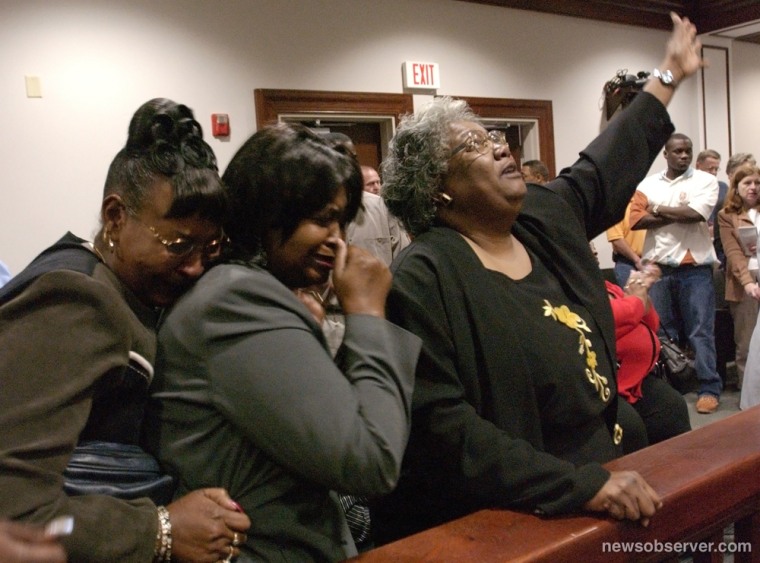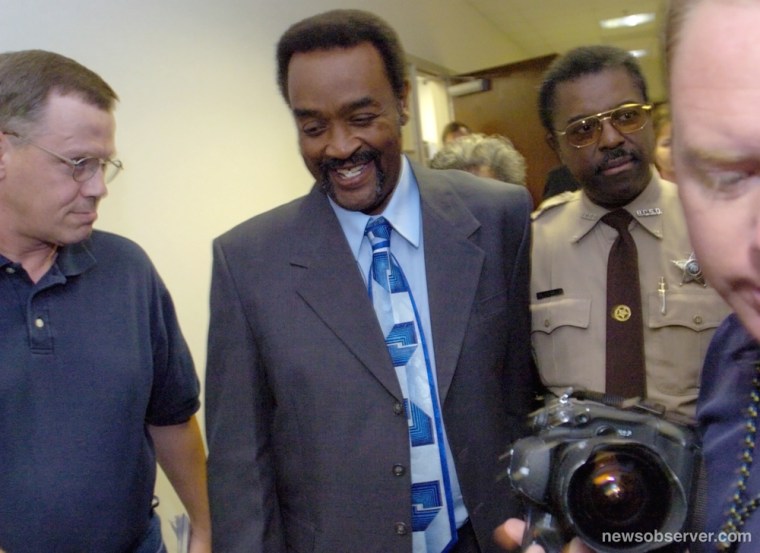In 1984, two North Carolina girls, age 4 and 6, were molested. They told police their abuser was Sylvester Smith, who was dating the mother of one of the girls, and he went to prison for the crime.
Twenty years later, the victims recanted, saying their grandmother told them to blame Smith, and his conviction was overturned.
But the person they say who really molested them -- their cousin, who was nine at the time -- could not be prosecuted because he was under age at the time of the alleged crime. He is, however, serving a life sentence for another crime he committed in the meantime: murder.
Smith's case illustrates the fallout from false convictions: He lost roughly 20 years of his life to prison, while the alleged perpetrator was free to commit other crimes.
Smith's discarded conviction is one of nearly 900 such cases filed in the National Registry of Exonerations, a database of prisoners exonerated in the U.S. of serious crimes since 1989, that was made public on Monday. To qualify as an "exoneree," an individual must have been convicted and later relieved of all the legal consequences.
In compiling the database, researchers became aware of more than 1,100 other cases in which convictions were overturned due to 13 separate police corruption scandals, most of which involved the planting of drugs or guns on innocent defendants. Those exonerations are not included in the registry.
ExonerationRegistry.org is the largest database of its kind ever assembled, according to its creators from the University of Michigan Law School and the Center on Wrongful Convictions at Northwestern University School of Law. Nonetheless, researchers are not able to say what percentage of convictions in the U.S. are false, in part because it can take so long for new evidence to come to light. There are currently about 2.5 million people in prison in the United States.
The earliest cases in the database date back to 1989, when DNA evidence freed its first two prisoners.
"We can figure that as sort of the modern period in exonerations because DNA was a big game-changer," said University of Michigan Law Professor Samuel Gross, one of the registry's creators. "It provided a scientific instrument for reviewing cases and providing a different type of evidence about those cases because the technology didn't exist."
But DNA doesn't actually account for the majority of the exonerations in the database, after an initial wave in the early 1990s, he said.
"DNA is a fairly narrow-gauged tool. It only fits particular type of crimes," Gross said, noting that only 37 percent of the people in the database were cleared with the help of DNA evidence. "In the public mind, exoneration became identified with DNA... Most of these cases -- DNA and non-DNA -- everybody agrees there was a mistake; frequently because the criminal was caught, often because we agree there was no crime at all."
Gross co-authored a report on the database that pulls together statistics on exonerations from January 1989 through February 2012. While the database is constantly updated and new exonerations are being added all the time, the report focuses on the 873 individuals whose cases had been filed before March.
Gross and his report co-author, University of Michigan law school graduate Michael Shaffer, discovered correlations in the types of crimes and reasons for wrongful convictions.
- Fabricated crimes. False convictions in child sex abuse cases were usually due to fabricated crimes; sometimes a divorced parent told a child to make up lies about an ex-spouse abusing them, or police or a therapist convinced a child to say something that wasn't true.
- Eyewitness mistakes. In adult rape cases, for example, false convictions were typically based on eyewitness mistakes, "more often than not, mistakes by white victims falsely identifying black defendants," the report said.
- Misconduct by authorities. For homicides, misconduct by authorities was the second-biggest cause of false convictions, just behind false eyewitness accounts.
Eyewitnesses are crucial to a trial, experts say, and their mistakes, whether intentional or not, can have a huge impact.
"The bulk of the evidence that is presented in trials in human testimony. Almost all of the time, energy, and effort is spent hearing people's statement in what occurred at a different place and a different time," Dan Simon, a professor of law and psychology at USC, said. "The bottom line is, people are often inaccurate."
Asking an eyewitness to identify a suspect from a lineup demonstrates this.
"There's a nice study that shows slight variations in the way the lineup is conducted can result in swings of accuracy from as low as 14 percent to as high as 86 percent," Simon said.
Confessing to a crime you didn't commitAnother factor in false convictions is what happens in the interrogation room. The report tracks 135 people who falsely confessed to a crime, and went to prison as a result.
"Why would anyone ever admit doing a terrible crime they didn't do?" Gross said. "The first thing to note is the risk false confessions goes up rapidly when the suspects are either juveniles or mentally handicapped or both."
In other cases in the database, a comment made to authorities was misinterpreted as a confession, or police pressure led to the false confession.
How effective are police lineups? Take our test
"Some people are being interrogated at a time of extreme mental anguish and distress," Gross said. "There was a very depressing case from Lake County, Illinois. He confessed to raping and murdering his young daughter, 8 or 9 years old, and a friend of hers. But consider the circumstances. He was being interrogated by the police, probably for 10 or 20 hours, within a day or two of when his daughter was kidnapped, raped and murdered and then they turned on him."
Exonerees can be found in all parts of the country, but most were concentrated in Illinois, New York, Texas, and California.
- 93 percent are men, 7 percent women;
- Nearly 50 percent are black, 38 percent white, 11 percent Hispanic and 2 percent Native American or Asian;
- 48 percent had been falsely convicted of homicides, 35 percent of sexual assaults (23 percent adult, 12 percent child), five percent robberies, five percent other violent crimes, and seven percent drug, white-collar and other non-violent crimes.
As a group, they spent more than 10,000 years in prison, an average of more than 11 years each.
Free from bars, but not from stigmaSmith, the man from North Carolina who was accused of molestation, maintained his innocence all along. He was only freed after one of the victims spoke to the other and decided to come forward in 2004.

"They said they were more or less encouraged to accuse Mr. Smith, but it took a number of years and a great passage of time," Smith's lawyer, Roy Trest, said. "Obviously, he was extremely elated after all the years he had spent in prison."
Smith asked for a pardon from the governor, but was denied.
Now 61 and in poor health, he lives with his wife -- who he was married to but separated from before he went to prison -- in Brunswick County, N.C., and has established a friendship with one of the victims who accused him, his lawyer said.
Not all exonerees who leave prison are able to reintegrate back into society like Smith, despite a court proclaiming them innocent.
"Even if people honestly believe that this person was truly innocent, there is a certain stigma that comes with the mere fact that you were in prison," Simon said. "You were with bad people, you were antisocial, you had to live in the jungle-like societies you often find in prisons."
Sometimes, families break up when a defendant goes to prison. Finding a job after release can be hard too.
"Often times, the state is really unhelpful. There is no automatic method to get your criminal record expunged," Simon said. "And they have huge holes in their results, and often times they lack the skills that would help you get a job. Everyone else was studying while you were stuck in a cell."
Simon believes the registry will help reform the justice system because it helps experts analyze the causes of false convictions. The creators are still adding cases to ExonerationRegistry.org. Gross said he hopes exonerees will contact his team if they had their convictions overturned and don't see their story in the database.
More content from msnbc.com and NBC News:
- Analysis: Possible outcomes for John Edwards
- Great-grandma: Ready to 'lose' my life protesting
- US war veterans return medals at NATO protest
- Father of 30, by 11 women, wants state child support
- Marijuana grows openly in California towns, not just for medicinal purposes
- Video: Facebook founder Mark Zuckerberg gets married
Follow US News on msnbc.com on Twitter and Facebook
